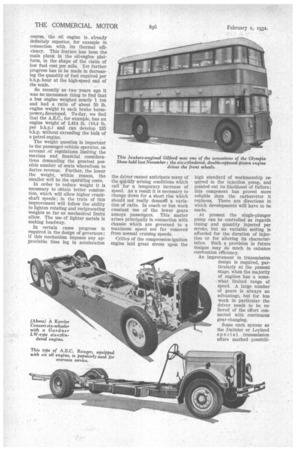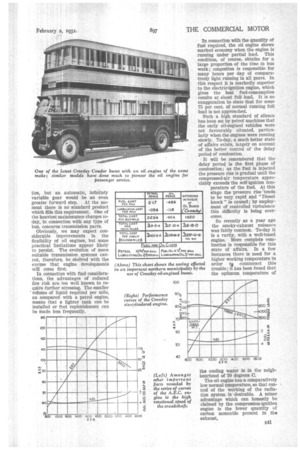THE OIL ENGINE
Page 97

Page 98

Page 99

If you've noticed an error in this article please click here to report it so we can fix it.
for the coach and bus of to-morrow
What Has Been Achieved in the Develop ment of Suitable Power Units for Passenger Vehicles. Directions in which Further Progress has Still to be Made
WHEN it is considered that, in this country at any rate, the petrol engine has had 25 years' existence as opposed to some three years in the case of the oil engine, it is remarkable what a degree of efficiency has been attained with the
latter form of prime mover. Carburetter engines have set such a high standard that the sponsors of the high-speed injection motor are faced with a difficult task.
One of the results of transport development has been the gradual increase in road speed of passengercarrying machines. This will, of course, continue, but to a less marked extent. In consequence, the oil engine has, at an early stage in its history, to provide a performange of a high order. This is already a practical possibility, without undue recourse to the gearbox. At present the rate of acceleration is somewhat inferior to that of a petrol engine, but the inevitable improvement in combustion efficiency will automatically correct this.
Upon this improvement in combustion depends practically the whole of the future of this class of engine. With a few exceptions, the excess-air ratio is rather poor, with a consequently lower brake mean effective pressure and a higher weight-to-power ratio than are desirable. The researches of Ricardo, Lang, and others have already borne practical fruit, and the propagation of the principles involved will rapidly raise the standard of performance, not only to that now obtaining in the case of petrol engines, but inevitably to a higher plane. In certain directions of course, the oil engine is already definitely superior, for example in connection with its thermal efficiency. This feature has been the main plank in the oil-engine platform, in the shape of the claim of low fuel cost per mile. Yet further progress has to be made in decreasing the quantity of fuel required per b.h.p.-hour at the high-speed end of the scale.
So recently as two years ago it was no uncommon thing to find that a bus engine weighed nearly 1 ton and had a ratio of about 50 lb. engine weight to each brake horsepower# developed. To-day, we find that the A.E.C., for example, has an engine weight of 1,414 lb. (10.4 lb. per b.h.p.) and can develop 135 b.h.p. -without exceeding the bulk of a petrol engine.
The weight question is important to the passenger-vehicle operator, on account of regulations limiting the maxima and financial considerations demanding the greatest possible number of seats wherefrom to derive revenue. Further, the lower the weight, within reason, the smaller will be the operating costs.
In order to reduce weight it Is necessary to obtain better combustion, which will allow higher crankshaft speeds ; in the train of this improvement will follow the ability to lighten rotating and reciprocating weights so far as mechanical limits allow. The use of lighter metals is making headway.
In certain cases progress is required in the design of governors ; if this mechanism imposes any appreciable time lag in acceleration the driver cannot anticipate many of the quickly arising conditions which call for a temporary increase of speed. As a result it is necessary to change down for a short rise which should not really demant a variation of ratio. In coach or bus work constant use of the lower gears annoys passengers. This matter arises principally in connection with chassis which are governed to a maximum speed not far removed from normal cruising speeds.
Critics of the compression-ignition engine laid great stress upon the high standard of workmanship required in the injection pump, and pointed out its likelihood of failure; this component has proved more reliable than the carburetter it replaces. There are directions in which developments will have to be made, At present the single-plunger pump can be controlled as regards timing and quantity injected per stroke, but no variable setting Is afforded for the duration of injection or for altering its characteristics. Such a provision in future designs may do much to enhance combustion efficiency.
An improvement in transmission design is required, particularly at the present stage, when the majority of engines has a somewhat limited range of speed. A large number of gears is always an advantage, but for bus work in particular the driver needs to be relieved of the effort connected with continuous gear-changing.
Some such system as the palmier or Leyland special transmission offers marked possibili
ties, but an automatic, infinitely variable gear would be an even greater forward step. At the moment there is no standard product which fills this requirement. One of the heaviest maintenance charges today, in connection with any type of bus, concerns transmission parts.
Obviously, we may expect considerable improvements in the flexibility of oil engines, but some practical limitations appear likely to persist. The evolution of more suitable transmission systems cannot, therefore, be shelved with the excuse that engine developments will come first In connection with fuel considerations, the advantages of reduced fire risk are too well known to require further stressing. The smaller volume of liquid required per mile, as compared with a petrol engine, means that a lighter tank can be installed or fuel replenishment can be made less frequently. In connection with the quantity of fuel required, the oil engine shows marked economy when the engine is running under partial load. This condition, of course, obtains for a large proportion of the time in bus work ; congestion is responsible for many hours per day of comparatively light running in all gears. In this respect it is markedly superior to the electric-ignition engine, which gives the best fuel-consumption results at about full load. It is no exaggeration to state that for some 75 per cent, of normal running full load is not approached.
Such a high standard of silence has been set by petrol machines that the early oil-engined vehicles were not favourably situated, particularly when the engines were running slowly. To-day, a much better state of affairs exists, largely on account of the better control of the delay period of combustion.
It will be remembered that the delay period is the first phase of combustion ; as the fuel is injected the pressure rise is gradual until the compressed-air temperature appreciably exceeds the self-ignition temperature of the fuel. At this stage the .pressure rise 'tends to be very rapid and "Diesel knock" is caused ; by employment of controlled turbulence this difficulty is being overcome.
So recently as a year ago the smoky-exhaust nuisance was fairly common. To-day it is a rarity, with a well-tuned engine. More complete combustion is responsible for this state of affairs. In a few instances there is need for a higher working temperature in order tg counteract this trouble ; it has been found that the optimum temperature of the cooling water is in the neighbourhood of 70 degrees C.
The oil engine has a comparatively low normal temperature, so that control of the working of the radiation system is -desirable. A minor advantage which can honestly be claimed by the compression-ignition engine is the lower quantity of carbon monoxide present in tho exhaust.




































































































































































